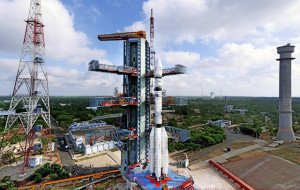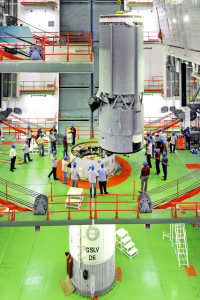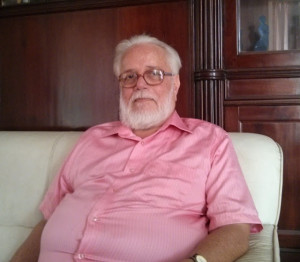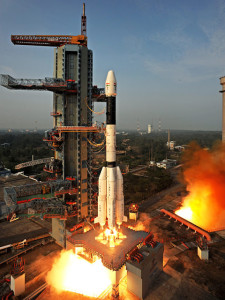Indian Space Research Organization did have another sweet success on 27th August 2015, which will be a vital part of Indian scientific history that made our nation proud by fortifying its position at the ‘Cryo Club’. ISRO has successfully completed the launch campaign of GSLV – D6 carrying India’s latest communication satellite GSAT – VI to a Geosynchronous Transfer Orbit (GTO). Equipped with the indigenous Cryogenic Upper Stage (CUS), the GSLV – D6 had a textbook lift off from the Second launch pad at SHAR. After undergoing the preparatory 29 hour countdown, the 416 tonne – 49 m tall GSLV-D6 carrying the 2117 kg GSAT-6, blasted off towards the sky as the clock ticked at16:52 Hrs.
At about T -5 seconds before the scheduled lift-off, the four external strap-on’s powered by a liquid propellant were ignited signalling the launch of GSLV-D6. Assisted by the solid propellant fuelled first stage core motor, GSLV blasted off carrying the dreams of ISRO high-up to the skies. With HSS separating the control room at SHAR, the GSLV team fixed its sight to the giant trajectory tracer. With the second stage successfully burning out and separating, the wait for the CUS ignition began. The indigenously developed CUS ignited, lifted the payload soaring up to the GTO and took a flawless flight. Following this, GSAT-6 separated from CUS at about 17 minutes after launch. The CUS or Cryogenic Upper Stage was a technology that took ISRO years to develop. The way CUS was constituted is no short of any thriller story!!! So what exactly followed India in mastering this technology?
The development of Cryogenic system is an extremely complicated process and often requires the best technologies available in the field to be implemented to obtain the most efficient result. ISRO worked years to master the technology, which was denied repeatedly by the world powers due to the fear of a reverse engineered ballistic missile technology. The GSLV program was constituted in the 1980’s by the Indian government to master the technology for launching Geosynchronous satellites to GTO. The success of PSLV program led ISRO to retain junk of major components used on the PSLV and decided to field the liquid fuelled Vikas engine. The barrier in attaining GTO was always the need to master Cryogenic technology.
USA and USSR were the only nations to master the complex cryogenic technology. India approached both the nations for this complex technology to be built in house and to be incorporated for its future missions.USA responding positively to the request had placed General Dynamics Corporation in charge for gifting India, its last piece in the space race. However, the cost overrun was a concern and America denied providing ToT. At certain key junctures, fearing a flank ISRO turned down the American offer. The next in the list was India’s trusted ally – Russia, which promised India the KVD-1, built by the Isayev Design Bureau. The KVD-1 had unsurpassed thrust and launch capabilities, the very same engine was developed as a part of Russia’s race to land men on moon. Russia offered two fully built KVD-1 and also promised a complete ToT, all at a mere cost of US $200 million deal.
On 18th January 1991, ISRO and Russian Space agency\ Glavkosmos signed an elaborate agreement for ToT of cryogenic engines. The ToT would propel India to the stellar ‘Cryo Club’, the technology mastered only by Russia and USA. Theoretically, India would also have a system that could be mutated to be an effective IRBM system with sustained efforts. Nevertheless, mutation was not an easy process and the use of hydrogen as a propellant in the upper stages meant that system could not be launched at moment’s notice as against the mandated launch time of ICBM system requirements. Even though this was personally aired to the Vice – President of USA by ISRO, America actively pursued every possible way to curb this development and landed upon the ‘violation of MTCR’ agreement by Russia. With the collapse of USSR, the economic downfall made Russia itself to be under the umbrella of USA.
With Russia and India not yielding to the international pressure, USA imposed sanctions on ISRO, Russian space agencies and chocked every development project implanted by ISRO with foreign collaborations. Under the pressure of Clinton, Russia finally backed down on the 1991 agreement and agreed to supply seven fully built engines and denied ToT. When Russia denied assisting with ToT, the race for an indigenously developed Cryogenic system was kicked off by ISRO. Very few breakthroughs were made in the coming years; India was forced to either work in incognito or to acknowledge the project by seeking the help of international players. Rumours of Russia covertly transferring the technology to India are a common part of this developmental story.
The conspired deal is captured by Brian Harvey in his book ‘Russia in Space: The Failed Frontier’. A small window for ToT opened up, when Russia ratified MCTR clauses. This mandated the deal could never be acknowledged by both the nations. Harvey quotes ‘ISRO contacted Air India and requested to transport the components and blue prints without revealing the details of parcels’. Air India soon turned down the request raising concerns about CIA that would be tipped off at the slightest developments on any Indian bound flights. The next in the list was Russia’s state run ‘Ural Airlines’, which readily agreed for the deal.
The risk was huge. However, the relationship between India and Russia was eternal. India was an ally that Russia could never manage losing and it went the other way around. An active spy ring of CIA was scouring Russia to catch hold of USSR’s technology. Russia then transferred the relevant documents, equipments and machinery on board covert Ural flights, which were accounted as transferring Indian aircraft technology to be tested in Russian wing tunnel facilities.
Every single flight had to be meticulously planned. Every component had to be accounted under a perfectly drawn cover story. The transfers to the planes had to happen in the dead of the night. The aircraft was officially carrying aircraft components from India, so the aircraft had to be sent to India with minimal load. Every cargo going on flight was personally being handled by Nambi Narayanan, who had made several trips to Russia. The risk of CIA or other intelligence agencies tracking the package was always a live threat. The way, components reached ‘VSSC, Thriuvananthapuram’ has been never revealed to the public. The risk was immense but Russia had covertly passed on the blueprints and basic technology to India for starting off with its indigenous cryogenic dream.
By 1992, work on the cryogenic systems had started in VSSC, Thriuvananthapuram under secrecy. Constant visit of top space brains to the facility had set-off alarms in Washington D.C. CIA by then had confirmed the existence of a project being actively pursued by ISRO to develop a powerful launch system. CIA had got wind of the project and soon tapped its sources in Russia, within months the free flow of technology to ISRO was confirmed and as an icing, CIA received disturbing news of India having achieved major breakthroughs in the project.
It is strongly believed by late 1994; ISRO had significantly mastered the technology and were in the process of implementing the complex tech barrier to attain a prototype. Unfortunately, a jolt had struck the project right at its heart; a major scandal involving key personnel of VSSC was aired in national news channels across India. Two eminent scientists Nambi Narayanan, Project Director (PD) of Cryogenic Upper Stage and D. Sasikumaran, In-charge of Propulsion were charged of leaking crucial information to foreign intelligence agency agents. Serious charges of Espionage were levelled against the top brains of ISRO. They were accused of transferring key developmental data to two Maldivian female intelligence officers after accepting millions for the exchange. The charges were grave and on 30th October 1994, Narayanan was arrested on charges of Espionage and transferring confidential data.
A detailed investigation by CBI, Intelligence Bureau (IB) found the charges to be purely fabricated at the behest of an unseen force. The whole case was dismissed by the honourable Supreme Court, the apex judiciary body in India. A compensation of around Rs 1.5 crore was awarded to each individual and every charge levelled was subsequently dropped. They never returned to the developmental wing of ISRO and VSCC, though they were reinstated in 1998. They were transferred and assigned Desk tasks at Ahmadabad and Bangalore. Narayanan was the one who introduced the concept of liquid propulsion in India, a revolutionary technology which changed the course of space capabilities possessed by ISRO. India’s celebrated ‘Chandrayan’ and the ‘Magalayaan’ missions were centric around the Vikas liquid propelled engines, a pet project of Narayanan. D.Sasikumaran was the man in charge of fabricating and manufacturing cryogenic systems. His designation today is in SAC, Ahmadabad that has no connections with cryogenic project. 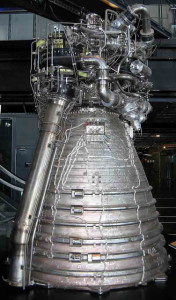
The real target was always compromising India’s quest for Cryogenic technology. India was extremely close to realize this dream. ISRO had set up test facilities in Mahendragiri, TN for testing the prototype that would be fielded for tests in the coming years. GSLV was designed to be a three staged rocket; a solid propellant motor was to fire the rocket during the primary flight just after the external strap-on’s separated. Led by India’s most celebrated scientist ‘APJ Abdul Kalam’, India had successfully developed the solid motor technology, where it was actively used in SLV and missile systems.
Next up was the liquid propellant fuelled systems, which was being mastered under the guidance of Narayanan. The upper stage was to be powered by cryogenic system, which India had imported from Russia at a whopping cost of US $220 million. India was a rapidly developing country, placing satellites in the GTO was a sheer necessity to India. Further import from Russia was economically unviable and seeking the help of USA was humiliating, this might be the possible force that kept us driving. Cryogenic systems were being developed by VSSC under SasiKumaran. India had the blueprints from Russia. The world had realized India’s capability in developing state-of-the-art technologies, given a clean slate. India was capable of putting up the best image. The case was complicated here, India had the technological know-how and the answer was to be derived methodically.
Given all the factors, India was bound to master the technology in less than a decade. The threat of India developing an IRBM was never a worry. Global powers had realized DRDO was way ahead in the GMP and was bound to bring the world under its reach. The real concern for global powers was the commercial interest. India was known to develop technology at the lowest possible production cost. The project rate itself would be extremely minimal. India was capable of offering extremely cost effective GTO missions to the other nations. A selected few nations had conquered this complex technology. The need was high. Every country needed a satellite for secure communications. Losing the market to a third world country was a concern for some of the leading countries. The only way out was to block India from developing a cryogenic engine.
Diplomatic pressure had failed to wind up the project. It had worked initially, with Russia denying it’s expertise to India. USA pulling up MCTR to the middle had thrown a spanner, right at India’s path. But the approach from ISRO was totally different. They had opted now to develop a system completely independent of any nation. With project being developed indigenously, there was no way India could be publically driven away from achieving a mile-stone. The only option was a surgical strike right at the heart of the program. India loved peace and the world had to reciprocate the damage peacefully. Any new drama’s unfolding would be met with a befitting reply from ISRO. Hence the blow was struck as covertly as the project itself had started. Two of its top brains were framed in a case that never had a solid allegation base, a case that saw some of the ugliest faces of Indian politics coming out from the darkest shadows.
The external force had succeeded in getting the top brains both directly in-charge of the cryogenic project being forced to abstain from work. Espionage was a serious allegation and demanded grilling and suspension, at the end truth had prevailed. Narayanan and SasiKumaran were held back from their office for 4 years, before being reinstated. The ‘Cryogenic project’ had suffered with the Project Director (PD) and the In-Charge of propulsion and Cryogenic systems had spent four years in the loop. The case was nothing short of a counter-intelligence operation, eminent people like Narayanan and SasiKumaran were merely the collateral in a massive operation against Indian interests. India’s Cryogenic dream was put on a back burner, for once the motivational level of ISRO was questioned. Yet, there are no barriers for reasoning and developing minds. And there’s ample of it in the ever capable ISRO, the Cryogenic dream is a reality dream today. We’re the members of the prestigious ‘Cryo Club’ and are one of the only few nation to posses this complex technology. Indians should be proud of developing this technology indigenously. In the mean time, let there be remorse that it was at the cost of careers of two brightest Indian minds.
The unexplained haunting theories will be on the role of foreign agencies in sabotaging the life of the scientist. Was there really any foreign agency involved in it or was everything a mere coincidence? Coincidence doesn’t play out in an organization, surely not in the case of two meticulously working scientist. So, who was it really at the end that had partially succeeded in shattering India’s dream project? Was it the Russians? Surely not!!! They worked with us. They had transferred the technology right under the diplomatic scanner. How about considering Pakistan? Well the possibility is real. But could Pakistan really get to know something Indian agencies had shrouded in secrecy, the world’s best agency, CIA, was yet to get a taste. ISI making a mark is really bleak. The other three in the list are a bit interesting, how about USA, France and China?
Well it sounds like a power league story. Those who really make anything out of the deal were only these nations. France was a nation that was still mastering the developed technology, the path for success was pretty far. France is a nation that had stood by India’s side even during its toughest time. Remember, France is one of the only nations not to have any impose sanctions on India shortly after nuclear tests. China is a possible conspirator, tensions were high, and then China itself was still developing the technology and was on the path to prove the Asian power to the world.
The rise of India would surely have been a concern for China, yet the resources at its disposal were extremely minimal. Was it really capable of pulling off such an orchestrated operation? The first on the list would be USA. America had successfully developed the cryogenic system and India relied heavily on their launch system.
Would you let your costumer develop on your technology? and on the top take away your clientele? Sounds a bit realistic, justified and worrying!!! Doesn’t it? Was it after all the world’s best spy agency CIA under the behest of Clinton, which had blocked ToT that had momentarily sabotaged India’s cold dreams? The question will never be answered. It’s our imaginations and our conclusions. For victims like Narayanan and SasiKumaran, the question haunts, their future stares at uncertainty. Despite all loses, we developed the technology and share honours with prominent providers of cryogenic engines.


